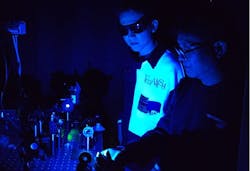Patterned waveguide boosts signal amplification within perovskite nanosheets
Pusan National University researchers led by Kwangseuk Kyhm, a professor of ultrafast quantum optoelectronics in the Department of Optics and Mechatronics, are boosting the signal amplification within perovskite nanosheets of cesium lead bromide (CsPbBr3) via a patterned waveguide.
Perovskites are extremely attractive materials for solar cell applications, but their nanostructures are now being explored as a new laser medium.
“Light amplification within perovskite quantum dots has been reported, but an inherent limit is present due to the Auger process. It essentially shortens the decay time for population inversion—a state in which the majority of the system is in higher, excited energy states than in lower, unexcited energy states,” says Kyhm. “And because perovskite nanosheets are two-dimensional (2D) structures arranged in sheet-like configurations on the nanoscale, the Auger process is relatively suppressed compared to quantum dots.”
An efficient laser medium requires a large gain, so Kyhm’s team turned to a patterned waveguide to enhance signal amplification with perovskite nanosheets (see video).
A boost in signal amplification
To enhance signal amplification, the researchers chemically synthesize high-quality CsPbBr3 nanosheets of a square shape, with an average lateral size of ~140 ±40 nm. Then, a periodic patterned polyurethane-acrylate (PUA) substrate gets filled with tiny perovskite nanosheets via a deposition process to form nanosheet stripes—and efficient light amplification occurs along these stripes.
“We used a new gain analysis of ‘gain contour’ to overcome the limit of earlier gain analysis,” says Kyhm. “While the old method provides a gain spectrum, it’s unable to analyze the gain saturation for long optical stripe lengths. Because the gain contour shows the variation of the gain with respect to spectrum energy and optical stripe length, it’s very convenient to analyze the local gain variation along spectrum energy and optical stripe length.”
It turns out, the team’s patterned waveguide is extremely promising for efficient and controlled signal amplification. “The optical confinement effect of the waveguide—patterned PUA substrate—is magnificent,” says Kyhm. “The gain coefficient increases, and thermal stability also improves.”
The researchers say the improved optical confinement and heat dissipation is thanks to 2D center-of-mass-confined excitons and localized states that arise from the inhomogeneous nanosheet thickness and its defect states.
This advance will enable the development of more reliable and versatile devices based on perovskite nanosheets, such as lasers, sensors, and solar cells. Beyond this, it could potentially be tapped for infosec, neuromorphic computing, and visible light communications. And, of course, enhanced amplification and increased efficiencies can improve perovskite solar cell performance vs. traditional silicon-based solar cells.
When intense light is needed at the nanoscale, perovskite nanosheets can be combined with other nanostructures to enable the amplified light to act as an optical probe. But bringing perovskite nanosheets into consumer products like smartphones and lighting will require overcoming stability, scalability, and toxicity issues.
“Perovskite quantum dots have been studied for lasers, but such zero-dimensional structures have fundamental limits,” says Kyhm. “Our work suggests that the 2D structure of perovskite nanosheets can be an alternative solution.”
What’s next? “The underlying physics of light amplification within perovskite nanosheets still needs to be verified,” says Kyhm.
FURTHER READING
I. Kim et al., Light Sci. Appl., 12, 285 (2023); https://doi.org/10.1038/s41377-023-01313-0.
About the Author
Sally Cole Johnson
Editor in Chief
Sally Cole Johnson, Laser Focus World’s editor in chief, is a science and technology journalist who specializes in physics and semiconductors.

